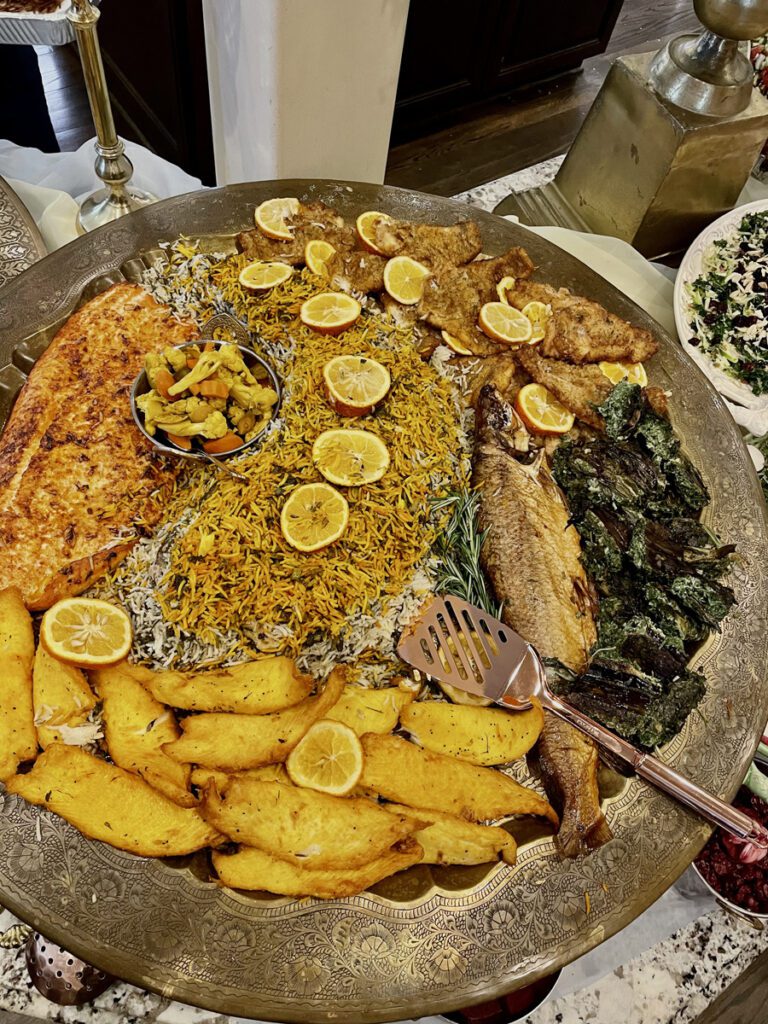Many diverse cultures worldwide take their cue from the sun—the spring equinox to be exact—when it comes to ringing in the new year.

Nowruz (“new day” in Persian) is a secular holiday celebrated globally by people of different faiths and backgrounds. Persian American Atlanta-based caterer Mojy Shahab loves celebrating New Year’s on the first day of spring. “It’s such a beautiful, happy season, and everything we do for Nowruz has meaning, from spring cleaning, visiting friends and family—especially the elderly—and preparing special food,” she says.
In anticipation of the March equinox, celebrants display a collection of symbolic food items known as the haft-seen, or Seven S’s, representing a hope for the new year. Shahab says sabzeh, a sprouted grain or grass, represents rebirth; senjed, dried fruit, is for love; sib, apple, signifies health and beauty; seer, garlic, is for health care; samanu, a sweet pudding, symbolizes wealth and fertility; serkeh, vinegar, connotes patience and wisdom; and sumac, a spice, represents the dawning of a new day.
“We then feast on a traditional meal that includes herbal rice with fish of any kind, noodle rice and an herbal frittata. Then, on the 13th day, when the Nowruz holiday ends, we celebrate again by going out to a park for more merriment where we take and eat a special noodle soup,” she says. Mark your calendars for March 21, 2023.
NOWRUZ MENU
Sabzi Polo Mahi (Persian Herbed Rice with Fish)
Ash-e-Reshteh (Persian Greens, Bean and Noodle Soup)
Kookoo Sabzi (Persian Herb Frittata)
Reshteh Polo (Persian Noodle Rice)
Assorted Persian Pastries
Sabzi Polo Mahi (Persian Herbed Rice with Fish)
Yield: 8 servings
INGREDIENTS
4 cups basmati rice
1 bunch each fresh dill, parsley, cilantro,
scallions (green tops only)
Neutral-tasting oil as needed
Saffron to taste (optional)*
8 portions cooked fish of choice
INSTRUCTIONS
To remove the starch from the rice, rinse in water and drain 3 times. Cover the rice with water and soak overnight. Bring a large pot of salted water to boil, drain the rice and add it to the pot. Boil, uncovered, for 6 minutes, or until the outer part of the rice is cooked but the inside is still hard. Pour the contents of the pot into a fine-mesh strainer to drain. While the rice is parboiling, clean, dry, stem and finely chop the herbs by hand or in a food processor.
To prepare the tahdig (the crispy bottom crust), generously coat the bottom of the pot with oil. Add a handful of rice to cover the bottom of the pot then top with some of the herbs. Add another layer of rice and top that with more herbs. Continue layering until all the rice and herbs have made it into the pot.
To collect the excess steam and keep the rice from getting mushy, cover/wrap the pot lid with a towel and gently press it over the pot. (Secure or fold the towel to keep it away from the burner.) Return the pot to the stove, turn heat to medium for 2-3 minutes then reduce heat to low and cook for 45 minutes.
Remove the lid, let the steam dissipate, then using your hands, gently incorporate the rice and herbs, taking care not to disturb the tahdig. Using a spoon, transfer the fluffed rice onto a serving platter, then carefully flip the pot over the platter until the crispy layer rests on top. Arrange fish alongside the rice, garnish dish with saffron/rice mixture if using and serve.
*If using saffron, grind a few strands into a powder, mix with 1 tablespoon boiling water, add mixture to 1 cup cooked rice and set aside.
MOJY SHAHAB
404.543.2276
@mojyshahab
STORY: Shelley Skiles Sawyer
Simply Buckhead is an upscale lifestyle magazine focused on the best and brightest individuals, businesses and events in Buckhead, Brookhaven, Sandy Springs, Dunwoody and Chamblee. With a commitment to journalistic excellence, the magazine serves as the authority on who to know, what to do and where to go in the community, and its surroundings.












